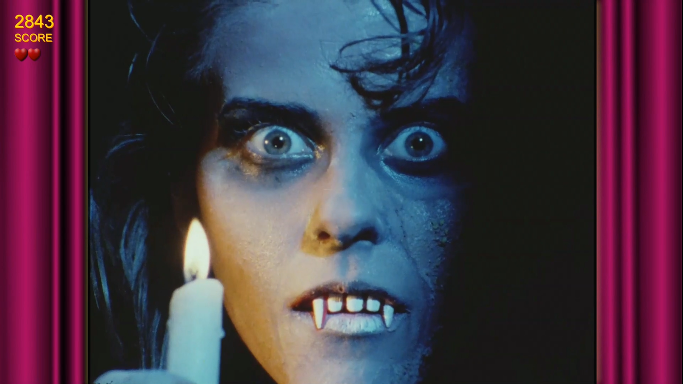
The Spectre Files - Deathstalker © 2019 Galloping Ghost Productions.
Become the star of an entertaining B-Movie horror film in The Spectre Files: Deathstalker. You take the role of Ed Spectre, a witty private eye who is in dire need of some cash. He takes up the case of a missing woman by the name of Buffy McGuffin, who disappeared while walking her chihuahua in a graveyard near the seemingly abandoned mental institute by the name of Derhachett Institute.
The gameplay is unusual for arcade games, even for laserdisc tech that it was originally based on. A clip will play, where at the end the player is presented with three choices. That choice will affect the others, either moving the story ahead with good choices, or hindering your efforts to solve the mystery with bad ones. While a player who makes nothing but poor choices can find themselves only playing for a few minutes, those who come back to play with different/better choices can go for quite a while on a single credit, even as long as 30-45 minutes.
The game features an entertaining sense of morbid humor, mixed with tongue-in-cheek fun and plenty of puns. Something of a hallmark with other games created by the designer, Brian F. Colin.
Originally designed in 1985 for Midway's laserdisc hardware. Unknown if this would have used the VideoDisc that sunk NFL Football, or the standrd laserdisc player that was used for Star Riders.
This modern restoration uses a Windows 10 PC that has been specially designed to work with a coin door. It interfaces with a standard LCD computer monitor via VGA and has three arcade buttons.
The cabinet was built by Prince Arcades in Illinois.
The Spectre Files was originally designed in 1985 by Brian F. Colin (Spy Hunter, Rampage, Arch Rivals, Xenophobe, many others). It was cancelled when it was about 95% complete, as the bottom had fallen out of the laserdisc market and Midway wanted to save face by going back to more traditional hardware designs.
The original footage was shot on 16mm film.
The game was cancelled after Midway's NFL Football had bombed. That game used a laserdisc variation called the VideoDisc, which used a needle. Even though they used a standard laserdisc on Star Rider, the laserdisc market had proven to be a fad at the time and Midway didn't want to keep spending money chasing the tech.
The footage and notes sat in a box for 30 years, until rediscovered by Mr. Colin. He worked with Galloping Ghost Productions in Illinois to digitally restore and remaster the footage and stitch it into a playable game.
As some of the footage was not completed at the time, and the technology today can work more efficiently than a laserdisc, the restored game uses a standard PC, with all content streamed from a hard drive. Gaps in the gameplay were filled in using modern HD graphics & clever editing, with new art created by Brian Colin and his company Game Refuge.
The original filming took about a month to complete. Shot at an abandoned, 13-story nursing home on the north side of Chicago, during one of the coldest February's on record (the building had electricity, but no heat). The film crew was made up of students from Southern Illinois University, directed by Brian Colin, who also served as one of the actors (you can see him in the game as the hippie, a tuxedo wearing zombie, the Flying Fryer, and others).
Sharon Perry, an animator at Bally Midway who was responsible for "putting the bow on Ms. Pac-Man," stars as Vampiress #1, the first creature you encounter if you enter the house through the front door.
The feature-length cut is disjointed (as you are supposed to make choices that can branch to other clips), but runs at 1 hour, 10 minutes if played non-stop.
While working on this was when Brian also began development of Rampage, which would be completed and released in 1986.
The Galloping Ghost Arcade in Brookfield, IL used their production arm to help complete the restoration efforts. They introduced the first cabinet for the game at their location in November 2017, and produced units that began shipping in January 2019.
Galloping Ghost is making 10 limited edition units that feature the logo of the arcade venue that purchased the game during the attract mode. 40 other units will be made if there is demand for it, capped at a production run of 50.
Galloping Ghost wanted to use a laserdisc player and CRT monitor for the new build, but the availability and reliability of the aging tech led them to use modern solutions.
| While the game has a scoring system, it is not entirely clear how choices are rated, apart from good choices made quickly will receive a higher value than waiting. | |
| More points are awarded for collecting an item than making a directional choice. | |
| A timer of skulls counts down near the bottom of the screen shows you how long you have to decide. |
Game design, film director, game coding: Brian F. Colin
Modern hardware producer: Doc Mack
Game cabinet
Game's flyer
The Spectre Files restoration project announced; https://arcadeheroes.com/2016/04/14/spectre-files-deathstalker-arcade-teaser/
Cabinet unveiling at the Galloping Ghost Arcade; https://arcadeheroes.com/2017/11/03/back-80s-spectre-files-deathstalker/
Interview with Brian F. Colin, including many details on the original development; http://dailygrindhouse.com/thewire/video-game-scares-the-spectre-files-deathstalker-the-16mm-80s-horror-film-you-havent-seen-really/